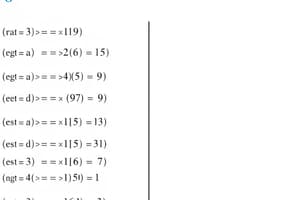Podcast
Questions and Answers
What do nested quantifiers allow for?
What do nested quantifiers allow for?
- Basic arithmetic operations
- Creating complex logical statements (correct)
- Graph theory applications
- Simple numerical calculations
In the statement 'For every integer x, there exists a positive integer y such that x + y = y,' what type of quantifiers are used?
In the statement 'For every integer x, there exists a positive integer y such that x + y = y,' what type of quantifiers are used?
- Conditional and existential
- Universal and existential (correct)
- Universal and conditional
- Existential and conditional
What is the purpose of using nested quantifiers in mathematical statements?
What is the purpose of using nested quantifiers in mathematical statements?
- To simplify the statements
- To add complexity for fun
- To allow for precise formulations (correct)
- To confuse the readers
How are the nested quantifiers utilized in the statement: 'For every integer x, there does not exist a positive integer y such that x + y = x'?
How are the nested quantifiers utilized in the statement: 'For every integer x, there does not exist a positive integer y such that x + y = x'?
Which of the following best describes the application of nested quantifiers in mathematical reasoning?
Which of the following best describes the application of nested quantifiers in mathematical reasoning?
Why is understanding nested quantifiers crucial in discrete mathematics?
Why is understanding nested quantifiers crucial in discrete mathematics?
Which type of quantifier is used to state that every element in a set satisfies a given condition?
Which type of quantifier is used to state that every element in a set satisfies a given condition?
What does the statement 'There exists x in X such that...' represent?
What does the statement 'There exists x in X such that...' represent?
Which of the following statements is an example of the universal quantifier?
Which of the following statements is an example of the universal quantifier?
What is the difference between the universal and existential quantifiers?
What is the difference between the universal and existential quantifiers?
What is the purpose of using quantifiers in mathematical statements and propositions?
What is the purpose of using quantifiers in mathematical statements and propositions?
Flashcards are hidden until you start studying
Study Notes
Discrete Mathematics: A Basic Introduction
Discrete mathematics is a branch of mathematics which studies discrete objects such as integers, graphs, and logic, in contrast to continuous objects such as calculus, which deals with smooth shapes like circles and lines. In this section, we will introduce some essential concepts from discrete mathematics, including nested quantifiers.
Understanding Quantifiers
Quantifiers are used in mathematical statements and propositions to describe whether there exists or how many elements satisfy certain conditions. There are two types of quantifiers in mathematics: universal quantifier (denoted by "∀" or "for all") and existential quantifier (denoted by "∃" or "there exists"). These quantifiers can either work alone or be nested together.
Universal Quantifier
The universal quantifier states that every element in a set satisfies a given condition. It is represented using the symbol "∀" or "forall", and it reads as "For all x in X...". For example, consider the statement: "All prime numbers are odd". This statement uses the universal quantifier because it claims that all elements (in this case, prime numbers) have the property of being odd.
Existential Quantifier
In contrast, the existential quantifier declares that at least one element in a set has a specific property. It is denoted by the symbol "∃" or "exists", and it translates to "There exists x in X such that... ". For instance, the statement "There is a prime number between 100 and 150" uses an existential quantifier, indicating that at least one prime number lies within that range.
Nested Quantifiers
Nested quantifiers refer to situations where quantifiers are placed inside one another. This can create complex logical statements, allowing for more sophisticated reasoning about discrete objects.
Example 1:
Consider the statement: "For every integer x, there exists a positive integer y such that x + y = y." This statement contains nested quantifiers because it combines a universal quantifier for all integers "x" and an existential quantifier for a positive integer "y". The nested quantifiers indicate that for each integer "x", there is a positive integer "y" that satisfies the given condition.
Example 2:
Another example is the statement: "For every integer x, there does not exist a positive integer y such that x + y = x." This statement also includes nested quantifiers, but with a negative existential quantifier (not ∃) that indicates no such positive integer "y" exists for any integer "x".
Conclusion
Understanding nested quantifiers is crucial to understanding complex mathematical statements involving discrete objects. By using combinations of universal and existential quantifiers, we can formulate precise statements and build a solid foundation in discrete mathematics.
Studying That Suits You
Use AI to generate personalized quizzes and flashcards to suit your learning preferences.




